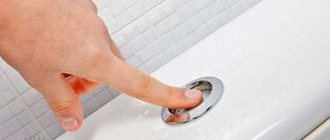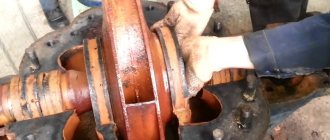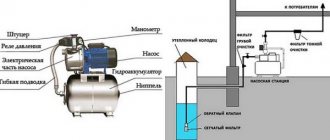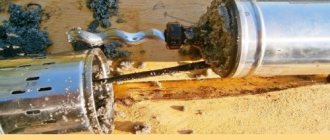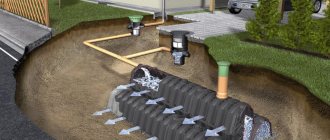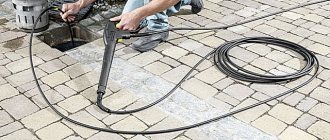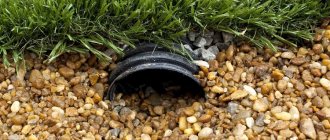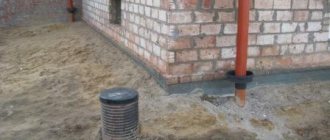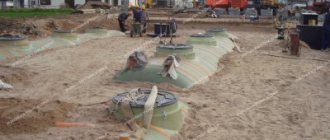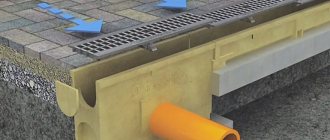Repair of storm sewers, or at least a preventive inspection, in an amicable way, should be carried out at the end and beginning of the operating season, which coincides with the warm season. After all, during the winter, at least one or two structural elements of the surface drainage system will suffer from linear deformations provoked by frost.
And in this article we will consider a set of measures aimed at restoring a faulty storm drain, touching upon preventive work that can be used to maintain the functionality of the drainage system for an indefinitely long time.
Storm sewer repair
Routine maintenance of external drainage systems
In order for your drainage system to last the entire warranty period and even longer, it needs periodic preventive inspection and cleaning of external contaminants and debris. It is pollution and debris that most often cause stagnation of water in gutters and storm pipes, disrupting the functionality of the entire system and often leading to disruptions and damage to its elements. As a result of debris accumulation, water stagnation, metal corrosion, or hardened contaminants appear.
First of all, when inspecting, you need to pay attention to those places that are most often susceptible to obstruction of debris: this usually happens at the junctions of system components. In such cases, it is necessary to clean the drains from debris.
Debris and leaves from drainage systems must be periodically removed
During operation, damage to drainage elements occurs due to mechanical influences. Particularly common consequences are the appearance of cracks after hail, ruptures and deformations after water freezes at subzero temperatures.
Technological principle of pipe repair according to CIPP
The main working element of the CIPP technique is a tubular insert (liner). This element is made from various materials:
- polyester,
- fiberglass fabric,
- felt fabric,
- carbon fiber,
- others.
The main requirement for the liner material is that it must have a porous structure that can be impregnated with epoxy (polyester) resin.
Honda EU10i
This is how - by simply introducing a liner into a section of a damaged pipeline, a complete reconstruction of the damaged structure is carried out. All properties and technical parameters are saved
Such a liner, pre-impregnated with epoxy resin, is embedded inside the damaged pipe. The implementation process is usually carried out through an upper access point (a service hatch or a small excavated area of soil).
Calculation of the number of pipes
Also, engineering calculation determines the number of pipes required for a particular building and the method of their fastening. Usually the criteria for calculation are as follows. For every 10 meters of gutter installed around the perimeter of the roof, one drain pipe with a diameter of 100 mm is required. Sometimes the roof area, or rather its projection, is taken as a reference point.
The point is this. A roof slope with an area of, say, 100 square meters, installed at an angle of 30 degrees (to the horizontal), will absorb a larger volume of rainwater than a slope having the same area, but installed at an angle of 45 degrees. It turns out that the greater the angle of inclination of the roof, the less water will fall onto the slope. This means that it is advisable to calculate the amount of “received” water not by the area of the roof itself, but by the area of its projection onto the horizontal plane.
Experts believe that for every 100 square meters of roof projection, one drainage riser is needed. In addition, the complex design of the building often necessitates the installation of additional drainpipes. In particular, when calculating the drainage system, specialists take into account the presence of gables, bay windows, projections, and other design features of the roof and facade.
The cheapest drainage system is made of galvanized steel. This budget option is most often used by the housing and communal services system. The fact is that in the cities of central Russia, and even more so in the northern regions, utility workers have to clear the roof of snow, ice, and icicles. Any drainage system cannot withstand the impact of a crowbar.
If we talk about private buildings, they often use heating of the edges of the roof using a heat-conducting cord. The same approach is possible in elite buildings, but we cannot yet talk about the widespread use of an electric anti-icing system. Therefore, experts consider the use of galvanized pipes in drainage systems of mass housing estates to be the optimal approach. The crowbar destroys metal and plastic gutters approximately equally, and therefore it is advisable to use the cheapest material in order to replace old gutters with new ones every few years during repairs.
In private buildings, galvanized steel is rarely used; drainage systems are mainly made of painted metal, plastic, or metal with a polymer coating. A special charm is the copper gutters. This luxury is used, as a rule, in elite buildings covered with copper roofs. However, compatibility of the drainage system in color and texture with the interior of the building is a very common approach when choosing a material. Gutters and pipes made of PVC or metal are usually chosen to match the color of the roof, but sometimes the colors are combined, taking into account the color of the facade. So, gutters can be red or green to match the color of the roof, and pipes can be yellow or gray to match the color of the facade.
Disadvantages of In-Situ Vulcanization of Pipe
With the exception of commonly used sizing templates, tubular liners are usually made specifically for each new repair. The use of CIPP requires a bypass flow for the repair area while the liner is being installed.
Curing of resins can take 1 - 30 hours, depending on the diameter of the pipe and the curing technique used (steam, water, ultraviolet).
The interior of the pipeline must be completely free of obstructions. The final result of hot vulcanization of labor is carefully checked.
BISON ZIG-2000
This is what the result of checking the completed restoration work, obtained using a video camera, looks like. Here the inspection showed impeccable quality
The cost of using Cured-in-place pipe technology is approximately comparable to similar methods:
- shotcrete,
- thermoformed pipe,
- closed pipe fitting (close-fit pipe),
- spiral wound pipe.
One of the pronounced disadvantages of hot vulcanization technology is the residue of chemicals used in the reaction process necessary to restore pipes. These chemicals are hazardous to health and the environment.
The material traditionally used to make sleeves for standard pipe diameter sizes is usually felt. The sleeve made of felt has difficulty passing through pipe bends, wrinkles, and often gets stuck in the area of rounded corners.
After completion of the work, the interior of the repair area must be cleaned using high pressure water jetting.
Repair of drainage systems
The need to repair gutters arises in the following situations:
- rust began to clearly appear on the metal gutters;
- plastic gutters have cracks due to temperature changes;
- when there is wind, the drainage system rattles and sways;
- leaks occur at the junctions of gutters or storm pipes;
- Water overflows through gutters and does not exit through storm pipes at sufficient speed.
Wind rattling is usually caused by looseness in the way the gutters are attached to the wall or roof. The normal passage of water and its overflow through the gutters is facilitated by the presence of contamination or disruption of the plane of the joints with their silting.
Sometimes, in order to restore the normal functionality of the drain, you just need to tighten the clamps of the clamps and fasteners (eliminates rattling) and correct the broken joints. When leaks occur at the joints of structural elements, it is often enough to ensure the tightness of the connection. In some cases, this problem is eliminated by the use of special sealants. In cases where a structural element has too significant defects that repair of gutters cannot eliminate, it is necessary to replace its damaged areas. This may require the purchase of individual structural components.
Replaceable gutter design elements
Gutter repair prices
Today, a large number of companies offer services for repairing gutters on the roofs of private houses with prices that depend on the volume of operations performed and the degree of defectiveness of elements of drainage systems. From several prices:
- dismantling 1 m of system length - within 400 rubles;
- installation of a new element – 300 rubles;
- replacement of brackets – 100 rubles/piece;
- replacement of clamps – 100 rubles/piece;
- replacement of funnels and drains – 100-150 rubles/piece.
The advantage of metal over plastic
Experts believe that the advantage of a metal drainage system over a plastic one is that metal is not afraid of severe frost. But the plastic can crack, especially if it freezes suddenly, and the water in the drain freezes. It is even more advisable to install a metal drain in a building with a metal roof. However, it is worth considering that the metal drainage system makes noise, so those who like silence may not like this material.
Experts recommend using PVC drainage systems in buildings where the roof is lined with flexible tiles. The fact is that flexible roofing is often sprinkled with mineral chips, and during operation the crumbs flake off: they are washed off the roof along with rainwater. The crumbs, which have abrasive properties, scratch gutters and pipes. Small scratches do not affect the functional properties of a plastic drain, but abrasives can remove paint from metal pipes and gutters. After this, the structure begins to rust. Rust not only spoils the appearance, but in particularly advanced cases, it eats through the pipe or gutter, and a leak appears in the drain. Problems with installing external drainage
According to experts, a “secondary” attitude to the installation of drains gives rise to additional problems. Non-standard approaches have become especially characteristic during the crisis years. When building a house, they invest “the last of their money” into it, and therefore they decide to save on arranging the drainage system. However, during the operation of the building, it turns out that this approach was wrong: water from the roof splashes over the heads of passers-by (owners), and slanting rain floods the facade. Then they call specialists and ask them to attach a drainage system to an already completed building.
However, as stated above, gutter holders are attached to the rafters and sheathing during the roof construction process - even before the waterproofing (if any) and covering are installed. It is not so easy to “attach” gutters to a finished roof, especially if the roof is not “edged” with a fascia board. In this case, you have to get to the rafters to drive the hooks into them. But sometimes craftsmen find more affordable and reliable roofing elements (you have to use a creative approach) to install fasteners for gutters on them. As mentioned above, the most common gutters are made of PVC and painted metal. According to experts, the average cost of one meter of plastic drainage is from 150 to 200 rubles, and of metal (painted) drainage - from 200 to 300 rubles.
Customer questions about repairs
My well shaft is crooked, can this be fixed?
If, when digging a well, rings without locks were used, or were not installed level, the shaft may be bent. Whether it is possible or impossible to fix, this question can only be answered unequivocally by seeing the condition of the structure, but in most cases it is impossible to do. In such cases, it is recommended to install brackets to strengthen the shaft and prevent further movement of the rings.
I am not in the Moscow region, but in the Vladimir region, is it possible for me to order your services?
We are ready to service wells not only in the Moscow region and Moscow region, but also in neighboring territories. To clarify the details of cooperation, contact our specialists using the online chat, write to us by email or call us by phone +7 (915) 238-777-2.
The lower rings of my well have cracks and even part of the concrete wall has fallen to the bottom, what can be done in this case?
In this situation, a complete diagnosis of the well is required, with a technician descending into the shaft and visually inspecting the problem. Perhaps the shaft is so twisted that it will not be possible to repair the well, which could lead to the construction of a new one. If the curvature is not large, and the wall can be restored, the solution would be to repair the concrete ring, install brackets, and waterproof the seams.
The water has become cloudy and dirty, will repairs help?
You can probably get by with regular cleaning. In 90% of cases, the water becomes cloudy due to leaking seams, there is contamination at the bottom when the old layer of the bottom filter is washed away and silt, sand or dirt forms at the bottom of the hydraulic structure.
- Guarantee of the quality of our services
- Sample contract for well services
- Areas where we work
Storm drain
Many of us have repeatedly had to endure the lack of well-built and cleaned storm drainage systems with our own boots on rain-drenched streets. This is not due to heavy rain, but to the lack of an established rainwater drainage system. It cannot be ruled out that the storm drains on flooded streets were covered with asphalt during regular road repairs, or that this was a failure of the staff who did not clear them in a timely manner. The construction project of a building, street, or microdistrict must include storm drainage. As stated above, water should flow directly into the storm drain from the internal drain of the building.
Water “discharged” to the ground through the pipes of the external drainage system must also ultimately be removed from the streets through storm drainage. Sanitary rules strictly prohibit draining rainwater into the general sewer system, since the water washing the streets is contaminated with machine oils and fuel, and cleaning these components requires reagents that are not provided for in a regular sewer system.
From surface storm water drainage systems, water flows into the storm sewer system, and then to treatment facilities designed specifically to purify rainwater that has washed city streets along the way. This is how the city's storm drainage system is designed. In a private house, the owner, who has sufficient funds, also provides for storm drainage during the construction of the building and arrangement of the personal plot. As a rule, the drainage system of a land plot, storm drainage laid along paths, and other engineering infrastructure facilities are thought out and designed within a single system.
Experts recommend taking into account that sanitary services require storm water to be treated also in a private yard, and separately from the main sewer system. However, in practice there are few people who want to “clean up the rain”. More often, storm water, like other excess moisture that excessively floods the area, is diverted to the nearest ravine or to filtration fields.
Repair of internal drainage
An internal drain is one part of vertically installed pipes that penetrate a private house from the roof to the basement. They try to hide the pipes in the walls, so the pipes rarely crack or burst, because the temperature is always positive.
Usually the funnel that is installed on the surface of a flat roof fails. It is simply replaced with a new one. But this is associated with a rather complex repair process affecting the roofing material of the roof. Because the coating, which is a bitumen-based roll roofing, must cover the funnel fields. That is, replacing the latter means opening a section of roofing material. This must be done carefully so as not to break the tightness of the coating.
It is impossible to repair the drainage system from the inside if the pipes are embedded in the walls. If they are carried out separately from the supporting structures, then the repair is carried out in exactly the same way as in the case of pipe risers of the external drainage system. That is, replacing failed ones with new ones. The pipes are assembled using the socket method, so dismantling the defective section and installing a new one is easy.
Replacing an internal drain on a flat roof
Main structural elements of a sewer well
First, you should pay attention to what structural elements the sewer well has. The main ones can be called:
- Working tank.
- Mine.
- Neck.
- Bottom.
- Inspection hatch.
Also, in the case of using reinforced concrete rings, a layer of waterproofing is created, which can be represented by tape or waterproofing plastic materials. In the case of a plastic well, almost all structural elements are one design due to seamless production.
This image shows the parts of a sewer well: Manhole - cover - concrete ring - bottom (base) of the well.
Main problems with reinforced concrete wells
The main problems that may arise with a well made of reinforced concrete rings include the following:
- Horizontal displacement of the rings is observed in case of violation of the installation technology. Pressure from the soil, groundwater, as well as failure to maintain the level when installing the first ring can cause the integrity of the structure to be compromised. Horizontal displacement can lead to the fact that the waterproofing qualities are significantly reduced. Regulating rings, covers, cast iron kits and many other elements can also move.
- There is a small chance that the base material, which is concrete, will be destroyed. In addition, the ladder and brackets may be destroyed, which begin to become corroded.
- In addition, the waterproofing may be significantly destroyed, as a result of which sewage will enter the environment. Insulation can be destroyed for a variety of reasons, for example, due to displacement of rings or violation of installation technology.
Horizontal displacement of the rings, destruction of seams and the integrity of concrete can lead to a violation of the well’s tightness and the release of sewage into the environment.
All of these problems can significantly reduce the efficiency of the sewer system.
Preventive measures (routine maintenance)
To avoid problems, it is important to seal the most vulnerable areas - the joints where deformation and other damage occur most often. A rubber seal will help protect these areas; it is easy to use and provides good adhesion to various roofing materials.
Other important preventive measures:
- Each summer ends with a check of the seal: you should make sure that they have not weakened and that the seal itself is positioned correctly.
- Before autumn, check the drain - cracks and holes in it are the main cause of leaks. If the structure is made of galvanized steel, the holes are soldered. The trays are cleaned of leaves and debris. To protect the system, it is recommended to install a grille or mesh in advance.
- Often the cause of damage to the system and the appearance of leaks is ice, so you can install an anti-ice system, film or cable, on the roof. However, it will not protect against the negative effects of hail.
To avoid leaks, you can install a drain on the roof with seals; it is equipped with a minimum of additional elements and is easy to assemble and disassemble. If an element is damaged, it is enough to replace it, while adhesive systems require complete dismantling of the entire assembly and installation of a new one.
Remember that each system has a certain service life, after which it is cheaper to install a new one than to reanimate the existing one.
09.30.2020Return to list
